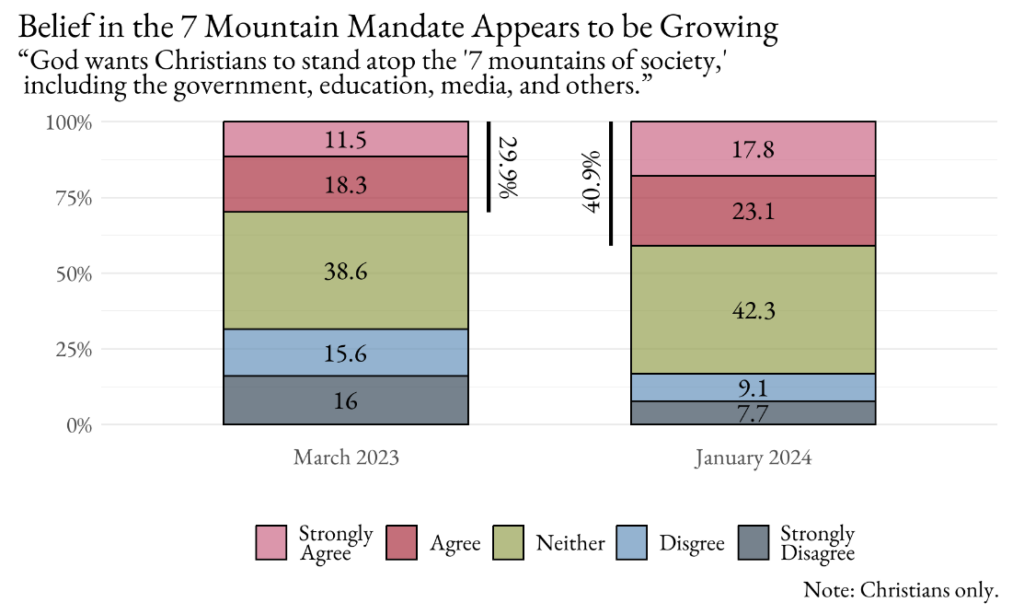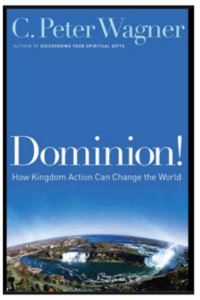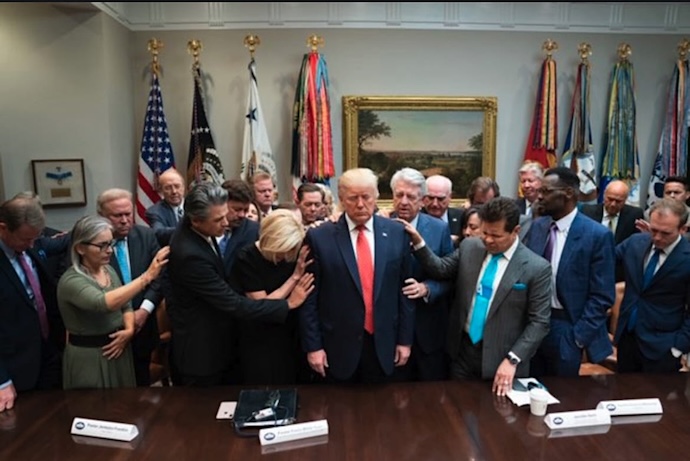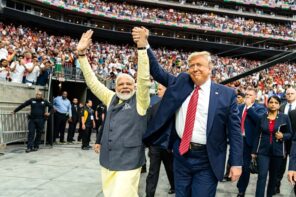The story of the New Apostolic Reformation (NAR) lives at the epicenter of the intersection of politics and religion in the US—and reporting about it is as essential as it is challenging.
The story of NAR is happening in the context of tectonic changes in global Christianity. It’s seldom reported that Pentecostal and Charismatic Christianity is the second largest sector of global and American Christianity, after Roman Catholicism. It’s also the only major growth sector. As we will discuss, the New Apostolic Reformation comes out of these traditions but doesn’t comprise the whole of the global movement. Rather, it’s a significant organizing element that has also become the cutting edge of the Christian Right in the US and in other countries.
In the current fashion among some to broad brush all of conservative evangelicalism as White Christian nationalism, it’s worth considering (as we document throughout this Guide) that the NAR is multi-racial, multi-ethnic, and multinational, but also defies stereotype because there are prominent women apostles and prophets (see Glossary).
Since we’ve both written a great deal about NAR and adjacent subjects, we want to address some of the most important matters of both style and substance that reporters will face when tackling this story.
It was a large undertaking and we’re glad we did it. Even though our original essays were published in 2022-2023, the Guide was already in need of revision and updates at this unsettling moment in history. It was originally a response to a combination of media inattention and mis-attention to an important religious and political movement, but it has evolved into something we hope will be a practical resource. The media environment has dramatically changed in the past year as NAR has emerged from the shadows at the center of public life.
What we’ve done here is to preserve the three-part structure as the essays originally appeared at Religion Dispatches, while revising and updating them to make it work as a single resource. As before, this guide is intended as a constructive, but necessarily incomplete effort to point to better ways forward. We include a Glossary and other resources at the end for ease of use.
***
PART I: The New Apostolic Reformation: Hiding in Plain Sight
The Christian Right, which has been an increasingly powerful factor in American politics for decades, has benefited from a strangely persistent culture of denialism. We needn’t review the number of times that reporters, scholars, and religious leaders declared that the Christian Right was dead, dying, or significantly diminished. That it’s still here and stronger than ever is sufficient reason for all of us to try to get it right.

Chief Justice Tom Parker of the Alabama Supreme Court discusses the 7 Mountain Mandate with Apostle Johnny Enlow, February 16, 2024. Image: YouTube/Restore 7 TV
The New Apostolic Reformation (NAR) is one of the most important Christian religious and political movements of our time. To see this one need look no further than the role of NAR leaders in the electoral campaigns of Donald Trump and Trump-aligned figures, from school boards to statewide elected offices, and as a dynamic part of the Christian Right.
The NAR has been most recently in the news regarding its close associations with House Speaker Mike Johnson and Alabama Chief Justice Tom Parker, among others. Nevertheless, there are still some who will claim that it doesn’t even exist. Others may deny or downplay the movement’s significance.
While we cannot cover everything here, we want to dismantle the main elements of NAR denialism and briefly show how they can contribute to misunderstandings of this important movement. We also want to show better ways forward and point to sources that anyone coming to this subject will find helpful.
Origins of the term
The term “New Apostolic Reformation” was coined in the 1990s by the late C. Peter Wagner, an expert on church growth and a professor at Fuller Theological Seminary. Wagner observed that churches outside denominational structures were the fastest growing in the US and worldwide, including in Africa, Asia, and Latin America. In them, he saw an emerging new paradigm that he and his close associates eventually sought to shape, organize, and lead.
Their vision of the NAR featured more than just networks of independent or nondenominational churches. It introduced historic changes to church governance featuring the restoration of modern day apostles and prophets and what’s called the “five-fold ministry” (see Glossary below). The NAR vision also draws on beliefs and practices from earlier religious movements, such as the Latter Rain movement in Pentecostalism in the post-World War II era and Christian Reconstructionism, which emerged from Calvinism and introduced dominion theology to the Christian Right in the 1980s and 1990s. Wagner and his close associates both introduced novel beliefs and practices, and revised others—steps which remain controversial and consequential to this day, such as the notion of “strategic level spiritual warfare” (see Glossary).
For Wagner all of these 20th century movements are to be understood as “components of the NAR,” as he wrote in a 2012 anthology on Apostolic Alignment. Most of what he would call NAR before and after he coined the term do not necessarily self-identify as such. This isn’t unusual. There are many such helpful terms used to describe broad elements of Christianity that few people use to describe themselves, such as Mainline Protestantism and Catholic Integralism.
While some have sought to limit the definition of NAR to the networks and organizations founded by Wagner, Wagner himself always saw the movement as much broader, and with good reason. For example, Donald Trump’s spiritual advisor, Apostle Paula White (sometimes Paula White-Cain), is a prominent example of a NAR figure who was not and is not part of Wagner’s networks and institutions.
And the movement continues to spread far beyond Wagner’s direct legacy institutions. This can be seen, for example, in NAR’s “Seven Mountain Mandate” or 7M for short, which was presented in Wagner’s 2008 book Dominion!. The idea was broadly popularized in the 2013 book Invasion of Babylon by Lance Wallnau and Bill Johnson. 7M fuses the movement’s notions of dominion theology and spiritual warfare, and makes this religious and political vision easily accessible for wide audiences—many of whom may never have heard of Wagner or the NAR.
The notion of the seven mountains has, according to one 2024 scholarly poll, been spreading rapidly and “now dominate[s] evangelical Christianity even beyond the portion of evangelicals in the charismatic/pentecostal camp.”

Image: Paul A. Djupe, Religion in Public
Although Wagner himself had traditional seminary training, including a Ph.D. from the University of Southern California, most of the NAR leaders have not. This contributes to the elusive nature of their religious identities and offices. But even while abhorring traditional higher education, NAR leaders are seeking to establish their own forms of credentialing, such as Wagner University and the controversial new Kingdom University.
Apostolic governance
Wagner was the movement’s guiding light and éminence grise for two decades, during which he served as convener of the International Coalition of Apostles 2001-2009 (ICA later changed to the International Coalition of Apostolic Leaders). ICAL is currently the most prominent and well-defined network within the wider “apostolic and prophetic movement.” It’s important to underscore, however, that it was and remains a network of apostolic leaders. Other networks also include thousands and tens of thousands of followers. There are numerous such networks around the world that are seeking to reorganize (they would say “restore”) ministerial leadership in the Charismatic and Pentecostal traditions in terms of what they call the “five-fold ministry.”
As we reported here on RD:
These networks are the implementation of the only form of church governance deemed legitimate and embraced by the NAR, called the ‘five-fold ministry’ (apostles, prophets, evangelists, pastors, and teachers), from the Book of Ephesians (4:11-13), which describes their role in the Church. The doctrines and denominations with which most readers will be familiar are, they believe, are under the influence of what Wagner called a ‘religious spirit’—sinful, arguably demonic, (see Glossary) obstacles to advancing the Kingdom of God on earth.
“In adopting the five-fold ministry, the NAR holds a continuationist view, meaning that God still calls individuals to exercise the roles of apostles and prophets in the Church today, along with all the spiritual gifts manifest during the early apostolic age, including healing, prophecy, and speaking in tongues.
One of the tricks in reporting this, is that people may mean different things by the terms apostle and apostolic. The Assemblies of God, the largest Pentecostal denomination, for example, issued a report in 2001 which states that most Christian denominations “think of themselves, in one sense or another, as apostolic.” But only the NAR/five-fold ministry churches “claim God has raised up present-day apostles in their midst.”
Even if the Assemblies of God recognizes that some church denominations name some of their leaders “apostles,” the report emphasizes that, “since the New Testament does not provide guidance for the appointment of future apostles, such contemporary offices are not essential to the health and growth of the church, nor its apostolic nature.” (See the Glossary for details.)
Nevertheless, the NAR is a growing movement and is playing a central and arguably disproportionate role in American public life.
Common wrong turns
A claim sometimes made by NAR apologists to confuse and deflect critics, is that the NAR is not an attempt to bring about a modern Reformation. C. Peter Wagner, however, thought that’s exactly what it is. He explained the reason for the name New Apostolic Reformation in his 2008 book, Dominion! How Kingdom Action Can Change the World.
The term “new” distinguished the NAR from what he called “old wineskin denominations that include the word apostolic in their names.” The term “reformation,” he explained, “denotes… that we are now witnessing the most radical change in the way of doing church since the Protestant Reformation.” 
The “Reformation” aspect mostly refers to the lineage of his version of dominion theology. It is decidedly Reformed as he traced it “back through R.J. Rushdoony and Abraham Kuyper to John Calvin.” Wagner’s “dominion theology” is essentially a re-packaging of “sphere sovereignty”—the idea that all areas of life must be brought under a comprehensive biblical worldview (see Glossary)—infused with Apostle Lance Wallnau’s 7 Mountain Mandate, which we define and discuss further below. This is a strategy that seeks to make ideas that can seem esoteric and arcane at once accessible and comprehensible to the people they’re trying to mobilize.
Since then, the most visible and politically potent form of Dominionism has certainly been charismatic in nature. In terms of eschatology—or End Times beliefs—the trend has been to move away from premillennialism, which generally emphasizes the idea that Jesus’ return precedes the establishment of his physical kingdom on Earth for a thousand-year reign, and towards what Wagner and others call a “victorious eschatology,” which promotes the idea that before the return of Jesus, the Kingdom of God will grow and fill the Earth, as the Church rises in glory, unity and maturity. For Wagner, “victorious eschatology fits dominion theology like a hand in a glove.” It’s the “primacy” of the cultural (or dominion) mandate over evangelism. Wagner believed in the total and complete victory of Christianity for eternity—as do most in the NAR and many beyond as well.
Turning a blind eye to the theocratic implications of the NAR’s theology of political power is of a piece with earlier denials of the existence or significance of Dominionism. These denials had partly to do with the role of Christian Reconstructionism (the Reformed movement led by 20th century theologian R.J. Rushdoony) in providing a theological rationale to engage in politics along with biblical justifications for an evangelical public policy agenda.

Journalist Bill Moyers interviews R.J. Rushdoony, Bill Moyers Journal, PBS, December 23, 1987. Image: Bill Moyers.com
This became something of a political crisis for conservative Republican candidates for president in 2008 and 2012 who were directly involved with Dominionists, including NAR leaders. Most dramatically, leading NAR figures staged an unprecedented prayer rally of some 30,000 people in Houston to launch Texas Gov. Rick Perry’s 2012 campaign. Even the octogenarian C. Peter Wagner traveled from Colorado to attend.
Like any other religious movement, not everyone is a ministerial leader, though the NAR seeks to create ministerial functions for everyone. For Wagner, social transformation largely occurs through what he called “the Church in the workplace.” This is how the idea of the 7 Mountains broadens the roles of religiously-inspired leadership. Each of these seven areas of culture (religion, family, government, business, education, media and arts & entertainment) can be a “ministry” that may have nothing to do with traditional church roles. Regardless, each area has everything to do with actualizing the vision of removing demonic forces from the pinnacles of power and replacing them with Christians intent on bringing about the Kingdom of God.
For more than two decades, the NAR has developed the 7 Mountain Mandate, as a mobilizing strategy which simply divides the world of cultural power and influence that Christians are to conquer in order to achieve full Christian dominion.
Missing the NAR dimension of politics can mean missing the story. For example, much about 2022 Pennsylvania GOP candidate Doug Mastriano’s relationship to the NAR went unnoticed in most reporting. This, despite the unusual aspects of the NAR’s role in the campaign, from blowing shofars at campaign events, to a March 2022 rally in Spooky Nook, Pennsylvania. An alert researcher found something that no one else had noticed in a video of the rally posted on the campaign’s Facebook page: in his remarks Mastriano reveals (at the 3:12 marker of the video) that he is God’s prophet, declaring, “God spoke through a donkey,” (referring to the story of Balaam in the biblical book of Numbers). “He’s speaking through Doug Mastriano right now.” Also, a WHYY investigation revealed that Mastriano’s campaign manager, Vishal Jetnarayan, “describes himself, and is described by others, as a prophet. He says he speaks with God directly and gives advice on how others can do so.”
Such relationships are not anomalies. Tom Parker, the elected Chief Justice of the Alabama Supreme Court has had a long and profound involvement in the NAR. House Speaker Mike Johnson’s relationship with NAR has also been in the news. Johnson has the Appeal to Heaven flag posted outside his office in the Capitol. Supreme Court Justice Samuel Alito has flown it outside his summer home in New Jersey. This flag, which was used during the American Revolution has become the unofficial battle flag of the NAR, most prominently by Dutch Sheets, and it was prominent during the January 6th insurrection. While it’s not clear that either Johnson or Alito is directly involved in the NAR, high profile government officials don’t choose which flags to display outside their homes and offices lightly.
Honorifics
Major Apostles and Prophets of the NAR are sometimes misidentified in news stories and magazine articles as pastors or evangelists. While they may be those things as well, the failure to more precisely identify the nature of their leadership and their church offices is a hefty understatement, and promotes critical misunderstandings of their roles. It’s like referring to Roman Catholic Cardinal Timothy Dolan as a Catholic priest. He is certainly that, but he’s no ordinary priest.
One article named the prominent Apostle Abby Abildness as a pastor, but according to her book bio on Amazon, she “was commissioned as an apostle by John Benefiel in 2011.” The bio on her organizational website shows her to be an important state political leader as well as an important international religious leader, although she does not, in this instance, mention her title as an apostle. In a different article, Apostle Ché Ahn, one of the leading apostles in the world, was simply described as an evangelist, with no further elaboration.
Identifying apostles and prophets is not always obvious, partly because they don’t always feature their offices. This may be because they’re opposed to what they sometimes call “the sin of religion.” This view is also expressed in their general opposition (some more fiercely than others) to denominations (hence, non-denominationalism) and even formal doctrines. (Some deemphasize the office itself and seek to focus on the function of the office.) It may also have to do with lowering their profile in relation to the society they’re standing against. But reporters don’t have to go along with the NAR PR program.
Another common mishap is to characterize various apostles and prophets as “self-appointed,” “self-proclaimed,” or “self-anointed.” At least in the networks established by Wagner, there is a process of mutual recognition of apostolic and prophetic leadership, as people having been called by God. And while self-appointment may be true for some opportunistic leaders in the wider apostolic movement, it’s important to establish when this is in fact true, rather than assume it’s always the case.
Similarly, while there is certainly an authoritarian, or at least anti-democratic streak in the NAR approach to religious and political authority, it’s more complicated than how the term authoritarian may be generally understood. Since the NAR and the wider apostolic and prophetic movement is so different from any kind of traditional Christian denomination, understanding of the five-fold ministry isn’t optional—even though it may take a few extra sentences to explain.
Another source of confusion is that NAR figures in the news are sometimes misidentified. Christian musician Sean Feucht, who also self identifies as a speaker, author, missionary, activist, and founder of multiple global movements, became prominent staging concerts protesting church closings and restrictions during the height of the Covid crisis. He also ran unsuccessfully as a Trumpian candidate for Congress in 2020. (Feucht will be much in the news in 2024, because of his campaign with Charlie Kirk’s Turning Point USA youth organization to promote Donald Trump.)
Some claim that Feucht is not NAR (or say nothing about his affiliation at all). However a simple look at his bio shows otherwise. Feucht was a volunteer worship leader at Bethel Church, headed by Apostle Bill Johnson, and went on to form his own ministry Burn 24-7, which has a Spiritual Oversight board listed on its website, comprising prominent NAR figures.
Just as with any other organization or movement, it’s essential to understand the nature, structure and ideology of the leadership, although it may take some research to do so. For those who are interested, there are some good places to look.
Although the NAR is best understood as a non-denominational and relational movement, C. Peter Wagner created several networks that serve as models for how to organize the movement. In 1991, he founded Global Harvest Ministries (GHM) and fully transitioned into Global Spheres in 2012. It’s now led by Apostle Chuck Pierce. By 2008, Wagner had reimagined GHM as a global apostolic network (see Glossary) with an organizational structure. Some of these networks are still vital today. While some have been renamed or rebranded, the movement has grown exponentially in the US and around the world.

Apostle Dutch Sheets on his daily Give Him 15 broadcast. Image: GiveHim15.com
In a July 2008 GHM newsletter, Wagner explained that many of these networks were created and led by apostles and prophets who were originally part of an intimate inner circle, the Eagles Vision Apostolic Team (EVAT) established in 2000 under Wagner’s leadership. Some of the EVAT members Wagner mentioned at the time are still prominent today, including John P. Kelly, Cindy Jacobs, and Dutch Sheets of Texas; Ché Ahn of California; and John Benefiel of Oklahoma.
On her profile page of the Strategic Prayer Apostolic Network, Apostle Rebecca Greenwood of Colorado states that she was a “member of Peter’s apostolic roundtable, Eagles Vision Apostolic Team, which is made up of those he considered to be his closest spiritual sons and daughters.” In his recent book Modern-Day Apostles, Ché Ahn mentioned other notable EVAT members at the time such as: Lance Wallnau, Ed Silvoso, and Bill Hamon.
EVAT was a close and exclusive network of 25 people who supported Wagner financially. It’s possible that some form of the EVAT network still exists—for example, some individuals still list membership in EVAT in their online bios since Wagner’s 2016 passing; see Robert Henderson and Peter Roselle. There is, unfortunately, no public membership list.
One thing to keep in mind is that apostles may not be the only leaders of “apostolic networks.” Prophets are also sometimes included on apostolic councils or teams. Ahn explains in Modern-Day Apostles that “because of the importance of working with prophets… I make sure that prophets are part of apostolic teams that I form.” One can therefore encounter “governmental” prophets on various apostolic councils and teams. Ahn gives the example of Prophet Lou Engle who’s on the International Apostolic Team of Harvest International Ministry.
Of course, just because apostles, prophets, and their own networks downplay their titles and their roles, doesn’t mean they’re necessarily hiding. They’re at the heart of the story. Primary sources to look for NAR leaders include the US Council of Apostolic Leaders, International Coalition of Apostolic Leaders, the Apostolic Council of Prophetic Elders, Strategic Prayer Apostolic Network, International Freedom Group, Wagner University, and The Oak Initiative, just to name a few.
[The field has vastly improved in the past year or two, so anyone looking into NAR-related subjects might consider the materials listed in the Further Reading section below.]
The knowledge and the vocabulary
Reporting on the NAR has significantly improved from a decade ago when its role in American politics and the implications for the future of democratic institutions was mostly ignored and sometimes ruthlessly downplayed. Some may continue to deny the existence of the NAR, and others may minimize its influence in public life. But such views are increasingly untenable.
It’s up to all of us, but especially journalists, to understand how the NAR’s theology of political power poses a threat to democracy. And in order for democracy and its institutions to appropriately respond, it’s essential that we get the story right. This means acquiring the knowledge that it takes to tell the story, as well as the vocabulary to be able to describe and discuss it.
***
PART II: Reckoning with NAR Terms and Their Meaning
The apostles of the New Apostolic Reformation lead large networks of great consequence in the United States and internationally. Even though top apostolic leaders have played important roles in public life for a generation, their names are barely known outside of the evangelical community except for the occasional magazine or news story. They are, however, well-known to aspirants for public office, especially Republicans.
But when these apostles and prophets, their apostolic networks, and their impacts are discussed, the relevant terms are often misused or misunderstood. In fairness, the networks that are the best-known features of the NAR, many of them formally organized in 1999, are still in their formative stages, and are constantly changing. Indeed, the movement’s goal is nothing less than the transformation, including some overturning, of 2000 years of Christian institutions, doctrines, offices, and theology.
Just as prominent apostles and prophets are sometimes described with inherently disparaging terms such as “self-proclaimed,” their church office titles are also sometimes inappropriately put in scare quotes, like “apostle” and “prophet” (see Glossary). Sometimes the legitimate term “apostolic leader” is misapplied when that leader actually holds a specific and easily identifiable church office.
If one is uncertain about the credentials of a given prophet, rather than employ the vaguely pejorative descriptors, “self-appointed,” “self-described,” “self-styled” or “self-proclaimed,” one might write, “who is seen by many as a prophet and whose prophecies are taken seriously.” The same standard may be applied to an apostle whose credentials are unknown or in question. One might write something like: someone “who is seen (or regarded) by many as a modern apostle and part of the wider apostolic movement in the world.”
This is not to say that there aren’t also grifters and opportunists—which needs to be noted if true. But if one can ascertain that someone is a recognized apostle or prophet in the NAR, there’s every reason to use the appropriate honorifics. But if one is going to accuse someone of being a grifter, we are obliged to prove it.
That said, NAR leaders themselves don’t always make it easy to identify their offices and roles, and, as we previously reported, they sometimes don’t use them. What’s more, the NAR is openly struggling over the appropriate role of the prophet in the Church.
To complicate matters even further, they tend to be distrustful of the media. Lance Wallnau, for example, a Texas-based Christian entrepreneur, apostle, prophet, and teacher has repeatedly claimed that the media is under the influence of a Leviathan demonic spirit that lies and twists the news and people’s words. Indeed, sometimes the media also give them reasons to be distrustful.
The following clarifications (and decoding of insider jargon) should be helpful.
What is an Apostle?
It’s important to underscore that the leading office of the NAR, the apostle, is not at all analogous to such common Christian church offices as bishops or deacons. NAR church offices are derived from the “five-fold ministry” (apostles, prophets, evangelists, pastors, and teachers) as outlined in the New Testament’s Letter to the Ephesians (4:11-13).
The NAR seeks to restore what they see as the First Century sense of the Church. This involves, of course, a massive demolition and restoration project: meaning that the old structures, doctrines, and offices of the Christian churches must be cleared away to make room for the arguably restored, “true” Christian church.
A leading NAR apostle, Ché Ahn, in his 2019 book Modern-Day Apostles, defines an apostle as:
[A] Christlike ambassador with extraordinary authority called and sent out by Jesus Christ with a specific assignment to align the Church to bring Heaven’s culture to earth and fulfill the mandate to disciple nations.
Distinct from the well-defined offices of traditional denominations, everything NAR is best understood as a work in progress. Fortunately, NAR leaders have developed some working definitions, as they figure out how to seize the 21st Century with their vision of First Century Christianity.
Longtime movement leader C. Peter Wagner distinguished between those who possess the gift (mentioned by God in 1 Corinthians 12) and those who hold the office of apostle.
According to Wagner, the office of apostle is achieved through works and is conferred by fellow apostolic leaders. It is the public affirmation that someone has the God-endowed spiritual gift and is worthy of assuming apostolic authority. Some therefore have the gift but have not yet (if ever) earned the recognition of the office by fellow apostles through a public “commissioning” ceremony.
Wagner’s definition seems clear enough, though in practice, the lines can get blurry.
Inspired by Wagner, Ché Ahn explains that there are also several subcategories of apostles, or, as in other fields where there are specialists such as in medicine or law, we might say there are apostolic specialists. These specialists include the following:
- nuclear church apostles, who minister in local congregations or apostolic centers;
- territorial apostles who are understood as having a God-given authority over geographical areas such as nations, states or cities.
- vertical apostles who oversee networks of churches or ministries.
- horizontal apostles who connect or convene various apostles, prophets or pastors.
- hyphenated apostles hold more than one office, such an apostle-prophet, apostle-evangelist or apostle-teacher.
- Some distinguish between strategic apostles and tactical apostles. There may very well be other such specialties.
- There is also a broader notion of apostleship: What NAR leaders call workplace apostles (also sometimes called marketplace apostles), however, don’t necessarily hold the office of apostle. They can be influencers, entertainers, entrepreneurs—basically anyone who strongly holds to an apostolic vision of advancing the Kingdom via one’s work.
For those seeking to fairly and accurately report on the NAR, in most cases an apostle meriting the honorific is someone who’s acknowledged as an apostle by others and leads an apostolic network—or is a commissioned apostle operating within such a network.
Therefore, this is how we define apostle:
An apostle is someone who, recognized by other apostles, exercises authority over individual leaders, churches, Christian organizations, or networks, and is responsible for establishing what they see as God’s governing order in designated spheres of ministry.
What are Apostolic Networks?
In his 1999 book Churchquake!, C. Peter Wagner referenced Apostle David Cannistraci’s explanation that:
[A]n apostolic network can take many forms. Essentially, it is a band of autonomous churches and individual ministries that are voluntarily united in an organizational structure. This framework of human relationships is sufficient to facilitate interdependency between network members and apostolic oversight.
Cannistraci identified four key components of apostolic networks:
- a recognized apostle or an apostolic team in leadership
- an atmosphere of dynamic relationships
- a distinct mission and purpose
- a gathering of apostolic churches (or centers)
Following from these statements, this is our simplest definition of an apostolic network:
An apostolic network is a band of autonomous churches and ministries that are united in an organizational structure sufficient to facilitate interdependency between network members and apostolic oversight.
In 2013, Wagner’s original network of apostles, led by Convening Apostle John Kelly, changed its name from the International Coalition of Apostles (ICA) to the International Coalition of Apostolic Leaders (ICAL). ICAL explains:
“[T]he function of the apostolic gift-bearing fruit is more important than the title ‘apostle’ and the majority of apostles throughout the world are called pastor, bishop, prophet, and some are called superintendents.”
This framing, then, allows like-minded leaders to retain their existing ministerial titles, which creates opportunities for apostolic networks to embed themselves in denominational settings for long-term influence without drawing unnecessary attention.
As a visionary and revolutionary movement, many NAR leaders see denominations and church offices as ossified, corrupt, and even demonic obstacles to the advancement of God’s Kingdom. They see that sometimes vanity can overcome even the best of apostolic leaders. This may be why ICAL declared that titles don’t really matter:
[What] matters is that all members of ICAL should be apostolically advancing the Kingdom of God fulfilling the great Commission and be recognized by their peers as apostolic leaders.
This expansively political view of the apostolic makes it additionally challenging for reporters seeking to identify a leader’s role in the church. We recommend using the publicly available information about individuals and church offices with caution. For example, the offices of the members of the related National Council of the US Coalition of Apostolic Leaders (USCAL) listed on the ICAL website are not identified. Some are known to be apostles, while others are prophets and/or teachers.
Creating new networks, rebranding old ones
Reporters also need to look beyond the well-established networks like ICAL and USCAL and be alert to new apostolic networks and older networks that have been rebranded.
New networks are created in order to identify, attract, and equip new generations of apostles. For example, Apostle Chuck Pierce of Texas launched Kingdom Harvest Alliance (KHA) in October 2021. He described it as “a new organism for alignment… a new wineskin that includes each one of us developing a harvest mentality for the sphere and calling we have. All wineskins usually have a seven year viability.”
It’s also important for reporters to be alert to the application of the metaphor “new wineskins” to the broad mission of the movement. Leaders like Wagner envisioned undermining and replacing traditional denominations—and what he called the corporate spirit of religion—which are seen as “old wineskins.”
In reporting on the NAR, one should note that networks that may appear to be new, may simply be rebranded versions of older apostolic networks. For example, in 1998, Wagner founded the Apostolic Council for Educational Accountability (ACEA). Its mission:
…was to provide schools/training programs identified with the New Apostolic Reformation a creative alternative way to establish credibility through accountable relationships… Some (educators) represented accredited universities while others represented church-based training schools. Most agreed that seeking traditional accreditation was not in their best interest and many were looking for an alternative.
Today, it’s been rebranded as the ACEA, which defines itself as “a network of Christian educators and administrators… called to influence and impact the education mountain.” Note that the “education mountain” refers to one of the Seven Mountains of dominion, discussed above. The network dropped “apostolic” from its name, but the mission is essentially the same.
There’s also prominent, longtime apostle, Bill Johnson’s Global Legacy out of California which describes itself as a:
relational network… that connects, encourages, and equips revival leaders worldwide. We expand God’s kingdom by helping to build relationships between revival leaders, ministries, and organizations around the globe, and to equip them to transform their spheres of influence.
Global Legacy has been rebranded as the Bethel Leaders Network.
It’s clear that one who’s regarded as an apostle or belongs to an apostolic network is not necessarily always part of the most Wagnerian segment of the NAR. The fact that the term “apostolic” is omitted from the name of a network means that reporters will have to uncover who is involved and leading it.
Commissioned apostles
Like leaders in traditional denominations, many important apostles were not among the much better and earlier known figures, and were commissioned much later. So a reporter looking at early lists of NAR apostles (which used to be openly published) may not find the newer apostles in this way, though these leaders are nevertheless shaping contemporary religion and politics.

Apostle Abby Abildness with 2022 Pennsylvania Gubernatorial Candidate, State Senator Doug Mastriano. Image: Healing Tree International
One of these, for example, is Apostle Abby Abildness of Pennsylvania. Abildness was commissioned as an apostle in the Heartland Apostolic Prayer Network of Apostle John Benefiel of Oklahoma in 2011. By 2017, Apostle–Prophet Cindy Jacobs, who heads Generals International out of Texas, asked Abildness to lead the new, statewide Pennsylvania Apostolic Prayer Network, a convergent effort by three networks to influence culture and politics in Pennsylvania, Generals International, Heartland, and the Congressional Prayer Caucus, (AKA the Congressional Prayer Caucus Foundation’s Pennsylvania Prayer Caucus Network, of which Abildness is the State Director. The latter also comprises the Pennsylvania Legislative Prayer Caucus, which advances the Dominionist legislative program formerly known as Project Blitz).
Abildness explains in a Facebook video how these networks seek to “bring transformation—from Pennsylvania to the nations.” She continues:
We are what Chuck Pierce and Dutch Sheets said, ‘we’re the governmental shift state, to bring this change in our nation.’

Apostle Mario Bramnick preaching at Lance Wallnau’s “Courage Tour” revival meeting and political training in Phoenix, Arizona, April 2024. Image: YouTube/The Lance Wallnau Show
Another notable commissioned apostle—not usually identified as an apostle in news stories—is Mario Bramnick of Florida, who describes himself as “part of Apostle Guillermo Maldonado’s Supernatural Global Network.”
Apostle Bramnick was a member of President Trump’s 2020 campaign Faith Advisory Board and is President of the Latino Coalition for Israel, which seeks to be the largest Hispanic Pro-Israel organization in America. For his part, Apostle Maldonado hosted the launch event for Evangelicals for Trump in 2020 at El Rey Jesús, a Miami megachurch from which he leads an apostolic network that he claims extends into 70 countries.
Just “nutty,” or nationally significant?
There are, of course, many reasons to get it right when covering NAR-related stories. But as writers we need to ask ourselves, how can readers be expected to understand the relative significance of a person or a movement if the language we use to describe it sandbags all sense of seriousness and proportion?
The NAR doesn’t merit our considered attention because some of the leaders may sound nutty to those outside the movement, but because it’s driven by theocratic notions of total societal dominion, including the end of democracy as we’ve known it. It also deserves our attention because it’s developed the political capacities to make these ambitions a lot less of a pipe dream than they seemed even a few years ago. This ought to be reason enough to end the era of glib dismissal and casual reporting of one of the most significant religious and political movements of our time.

Apostle Ché Ahn convened a Leadership Forum in July 2021. Revive California (HIM)
***
PART III: Global Reach
It’s fair to say that well established global trends in the Pentecostal and Charismatic movements reveal one of the most significant developments in the history of Christianity. These trends have been underreported, but the NAR’s role in helping to drive and define these trends has been even less well reported.
While US coverage has almost exclusively focused on the US context, the NAR plays an important role in the culture and politics of many other nations. That this massive, multidimensional trend is so underreported and its multinational and multiracial character, dimensions, and organization mostly missed, means that even our best understanding of the movement is often problematic.
In Parts I and II above we sought to highlight some of the history, leaders, and apostolic networks in the US and suggested some simple definitions and ways to avoid common mistakes in reporting on this still emerging movement.
We want to build on these by focusing on how the NAR operates internationally, offer some guideposts in reporting on it, and underscore that the same Dominionist visions and political activities that are hallmarks of the NAR in the US animate and define the international networks as well.
International networks
There are many apostolic networks with global reach. They’re often politically influential across continents and around the world and enjoy close relationships with prominent politicians and government officials.
What we outline here is necessarily far from comprehensive. We open some windows on the international presence and influence of the NAR by highlighting some of the leading apostolic networks, their leaders, and their multi-national, multi-racial and multi-ethnic character.
That said, the numbers of nations and people that we mention are sourced solely on the claims of the groups themselves. We have no way to independently verify these numbers, so they should be used advisedly.
Simply put, the global vision of the NAR is based on their understanding of the Great Commission text of Matthew 28:18-20, with an emphasis on “discipling nations” (28:19). International apostolic networks are therefore necessary for the apostles to lead the five-fold ministry (Apostle, Prophet, Evangelist, Pastor and Teacher) which was restored by God for the building-up of the Church (see Ephesians 4:11-13) (see Glossary). That’s why they seek “alignment” among one another. It’s also why the Texas-based International Coalition of Apostolic Leaders (ICAL) has, via its 2000 members, a reach in 87 nations. Part of ICAL’s vision is to network apostles “and help them move the Kingdom of God forward in their respective nations, regions and cities.”
As Donald Trump considered running for president, the movement faced the question as to how Christians could support such a blatantly immoral and unprincipled man. Their answer was that God sometimes selects such people to carry out his purposes. So Trump was compared to the ancient Persian King Cyrus, who freed Jewish prisoners and helped build the temple in Jerusalem. This provided evangelicals with a remarkable escape hatch from the political and moral norms that previously governed most evangelical engagement in public life.
These two elements also animate the NAR’s activities internationally.
‘It’s a 7M world’
In his book, God’s Chaos Code, 7 Mountains strategist and NAR thought leader Lance Wallnau (who is an apostle in Ché Ahn’s network) mentions such Cyrus-type political rulers as Brazil’s Bolsonaro, Poland’s Andrzej Duda and Hungary’s Viktor Orbán. These rulers, he says, would “preserve their nations’ religious values from the Western virus of cultural decay.” It’s understood that when Cyrus-type authoritarians are in power, Christians will facilitate the spiritual rebuilding of their nations.
It’s important for reporters to note the global intention and applications of the mobilizing strategy of the 7 Mountain Mandate. Wallnau stresses that “it is a 7M world… (and) these mountains exist in every nation, and the sum total of these mountains determines whether the nation is oppressed under the heel of a hostile government or whether it’s free, prosperous and blessed.” Historic changes in nations, Wallnau asserts, come through reformation, and “cultural change comes from the top down and rarely, if ever, from the bottom up.”
Reporters should also note that this is at odds with the bottom-up view expressed by other movement leaders in their 2022 statement about NAR and Christian Nationalism. Arguably it’s a distinction without a difference, because once these Christians have reached the pinnacle of the mountains, they intend to use their position to advance their view; in the end, it will be top-down.
[Jump to the list of Significant International Networks below.]
‘Patriotism of the righteousness of the Lord’
One of the challenges in writing about the global dimensions of the NAR, is the overuse by some, of the term “Christian Nationalism” in the US, which is too narrow to characterize the NAR—especially its politics. For example, just prior to the US elections in 2022, Abby Abildness, a Pennsylvania-based apostle in the Oklahoma-headquartered Heartland Apostolic Prayer Network, highlighted their concern, not just for the nation, but the nations—particularly Israel—in a video prayer call of the World Prayer Network (WPN) (1:32:20).
(Journalists note: WPN calls are open to the public, but they assert that the calls are church services. Therefore they “ask that no media or press be on the call. Nothing shared on the World Prayer Network is ever to be reported in the media.”)
Abildness prayed that “the patriotism of the righteousness of the Lord in our nation” would be revealed by the vote. Note that her notion of patriotism is to the righteousness of the Lord, not to the nation itself. She continued, “we are in a season of aligning with political comebacks in the nations, and we align in these networks with Israel, with Netanyahu who just had a wonderful victory; and Bolsonaro who is in the process of his victory being recognized.”
Bolsonaro’s electoral victory was not to be. But Abildness’s point was about the unity of the apostolic leaders on the prayer call. “[W]e join together in this network,” she continued, “aligning for your purposes for a righteous reign coming out of this election in the states, across America, and in our covenanted alignment with the nations, that the sheep nations, beginning with Israel, would come into the fullness of your Kingdom coming, on Earth as it is in Heaven.”

Apostle Lance Wallnau and Henry Matir, President of the Asian American Network in Phoenix, Arizona, April 2024. Image: The Lance Wallnau Show
This episode illustrates how Christian nationalism—NAR-style—is less about the American nation than the nation’s role in God’s intentions for the world, notably the State of Israel. Abildness’s role also epitomizes how the NAR defies stereotypical evangelicalism because there are many women in apostolic leadership.
Wallnau explains the idea of “sheep and goat” nations (from Matthew 25:31-40) that Abildness referred to. A sheep nation, he says, “protects or keeps malicious forces from devouring the Christian and Jewish people,” while a goat nation “has failed to show mercy” to Christians and Jews. He also believes that “the creation of nations was God’s idea.” Cyrus-type rulers of sheep nations are needed to ensure that Christian values are protected and that the modern State of Israel would be respected.
Of course it should be noted that their reference to the modern State of Israel is bound to their view of ancient Israel as depicted in the Bible, and their portrayal of Jewish people is far removed from the contemporary religious and secular reality. Thus it’s also noteworthy that NAR apostles and prophets are often leaders in the contemporary Christian Zionism movement.
A final word
In the Reporter’s Guide to the New Apostolic Reformation, we’ve culminated our review by highlighting that the NAR vision is always international and not merely a matter of parochial American nationalism. While each country in the NAR vision is to be a Christian nation, all nations are to be Christian because the Kingdom of God is as global as it is local.
The NAR also reaches into the US from other countries in much the same way that the NAR reaches other countries from the US. While this sense of global vision and mission isn’t new in Christianity, there’s much that is new in this important contemporary movement that demands attention and better reporting for the first, rough draft of history.
Glossary
Apostle An apostle is someone who, recognized by other apostles, exercises authority over individual leaders, churches, Christian organizations, or networks, and is responsible for establishing what they see as God’s governing order in designated spheres of ministry.
Apostolic Network An apostolic network is a band of autonomous churches and ministries that are united in an organizational structure sufficient to facilitate interdependency between network members and apostolic oversight. Such networks are led by one or more apostles.
Apostolic Center The hub of an apostolic network. They are displacing the traditional church or church building to accommodate the broad functions of the apostolic model of the five-fold ministry. They often seek to transform today’s churches into training, education, and mission centers. They function beyond pastoring local congregations by seeking to create communities of expanding influence with social and economic impact.
Biblical Worldview A biblical worldview seeks to look at the world through the all-encompassing lens of the bible as the word of God. This idea can be interpreted in many ways, but in an NAR context it will usually suggest a justification for conservative moral code, opposition to the values of secular, constitutional democracy, and guidance for how to advance the Kingdom of God.
Demons Supernatural spirits understood to be the source of the problems of daily life as well as conflicts between people and even nations. These forces constitute a hierarchy of high ranking demonic spirits (see Ephesians 6:12) that control nations, regions, cities, groups of people, and neighborhoods. They are the principal opposition to advancing the Kingdom of God on Earth and are especially important in so far as NAR figures believe they are living in the End Times and must do spiritual and physical battle with them. Demons of which NAR leaders often speak include Jezebel and Baal.
Dominionism The theocratic idea that Christians are called by God to exercise dominion over every aspect of society by taking control of political and cultural institutions. It is the underlying ideology of contemporary notions of Christian nationalism, providing at once a justification for political engagement and an agenda. It mandates the promulgation of a comprehensive “biblical worldview.”
Five-Fold Ministry Comprises the offices of the church—apostles, prophets, evangelists, pastors, and teachers as outlined in the New Testament’s Letter to the Ephesians (4:11-13). The restoration of these offices, which work together as a whole function is a key piece of how NAR seeks to restore what they see as the First Century sense of the Church. The doctrines and denominations of traditional Christian churches are deemed to be under the influence of a “religious spirit.” They are sinful, arguably demonic, obstacles to advancing the Kingdom of God on earth.
Prophet God speaks to and through his prophets of the Five-Fold Ministry. But it’s supposed to be apostles who judge, evaluate, strategize and execute God’s revealed word. Prophets are, therefore, expected to submit to the authority of the apostolic leaders. There have been controversies about various prophets and prophecies, particularly regarding the role of Donald Trump and the outcome of the 2020 election.
Spiritual Warfare This refers to the battle that supernatural forces of evil wage against Christians. It is believed that demonic forces are responsible for the problems of daily life as well as conflicts between people and even nations. Modern-day spiritual warfare practitioners believe that these demonic forces can be contained through the power of prayer, but also via social and political activism.
Strategic Level Spiritual Warfare This idea, typically rooted in an interpretation of Ephesians 6:12, is frequently cited by NAR figures: “We’re not wrestling against flesh and blood, but against principalities and powers, against rulers of darkness of this world, against spiritual wickedness in high places.” Accordingly, NAR leader C. Peter Wagner taught that demonic forces control nations, regions, cities, groups of people, neighborhoods and important networks around the world. Wagner referred to these as territorial spirits, or demons that oversee lower ranking demons bent on preventing the advancement of the Kingdom of God in their territory. NAR leaders often engage in public prayers of spiritual warfare against demonic forces they contend control the religious, political and gender identities of others. Once these “evil principalities” have been identified, they can be spiritually confronted via such practices as “prayer walking,” in which believers are invited to perform “intercessory prayers.” This sometimes takes the form of prayer walks in neighborhoods, but may extend to large geographical regions. Such practices are often conducted in tandem with long term efforts at political control.
Further Reading
Core Materials
- Right Wing Watch
- Christian Right Observer Weekly
- Video series on the New Apostolic Reformation and 7 Mountain Mandate
- Talk to Action, Resource Directory for the New Apostolic Reformation, (archived) by Rachel Tabachnick
Journalism
- Odette Yousef, Speaker Mike Johnson draws scrutiny for ties to far right Christian movements, National Public Radio, December 5, 2023
- Eliza Griswold, A Pennsylvania Lawmaker and the Resurgence of Christian Nationalism, The New Yorker, May 9, 2021
- Stephanie McCrummen, An American Kingdom: A new and rapidly growing Christian movement is openly political, wants a nation under God’s authority, and is central to Donald Trump’s GOP, The Washington Post, July 11, 2021
- Elle Hardy, The Right-Wing Christian Sect Plotting a Political Takeover: The New Apostolic Reformation doesn’t always admit its own existence, but it’s growing in influence in the Republican Party, The New Republic, August 23, 2022
- Keri Ladner, The quiet rise of Christian dominionism, The Christian Century, November 2022
- A groundbreaking, ten-part investigative podcast series on Straight White American Jesus by Matthew D. Taylor and Brad Onishi reveals the role of the NAR in the events leading up to and during the January 6 insurrection. This article summarizes their findings
- Katherine Stewart, The Rise of Spirit Warriors on the Christian Right: How an extreme transformation in American religion poses an existential threat to our democracy, The New Republic, January 23, 2023
- Frederick Clarkson, “Unfriending” America: The Christian right is coming for the enemies of God — like you and me, Salon, June 17, 2023
- Jennifer Cohn, Pennsylvania’s Prayer Warrior: Abby Abildness And Her Dominionist Crusade In The Commonwealth, Bucks County Beacon, July 11, 2023
- Paul Rosenberg, Meet the New Apostolic Reformation, cutting edge of the Christian right: Christian nationalism has new momentum — and a new movement that openly longs for “dominion” over secular America, Salon, January 2, 2024
- Molly Olmstead, The Radical Evangelicals Who Helped Push Jan. 6 to Wage War on “Demonic Influence”: Mike Johnson has deep ties to groups that encouraged the Capitol raid—out of conviction that they’re in a literal battle between supernatural forces of good and evil, Slate, January 6, 2024
- Chauncey DeVega, Trump’s mobilizing his “prayer warriors”: Religion scholar on what MAGA means by “spiritual warfare”: Professor André Gagné explains that MAGA’s “adoption of aggressive spiritual warfare language” is a warning sign, Salon, January 31, 2024
- Tim Dickinson, Mike Johnson Gathers Far-Right Christians to Cast Out Demons, Rolling Stone, February 6, 2024
- Peter Montgomery, A New Guide to the Theology That Drives Trump’s Dominionist Prophets and Apostles, Right Wing Watch, February 6, 2024
- Stephanie McCrummen, The Alabama Embryo Opinion Is About More Than Christian Nationalism: An insurgent religious movement is beginning to feel its strength, The Atlantic, March 5, 2024
- Jaxon White, Conservative lawmakers, faith leaders meet with Christian dominionist activist in Harrisburg, Lancaster Online, May 1, 2024
Academic Books
- American Evangelicals for Trump: Dominion, Spiritual Warfare, and the End Times published in 2024 by André Gagné
- The New Apostolic Reformation: A History of a Modern Charismatic Movement, published in 2016 by John Weaver
- The Violent Take It by Force: The Christian Movement That Is Threatening Our Democracy, by Matthew D. Taylor (Fall 2024)
Significant International Networks
*Archbishop Nicholas Duncan-Williams of Ghana leads United Denominations of Action Chapel International, founded in 1992. He describes himself as “The Apostle of Strategic Prayer.”
Duncan-Williams is known as the spiritual father of Apostle Paula White-Cain, who in turn is the spiritual advisor for Donald Trump. He claims that his network of over 500 churches in Africa, Europe, the UK and five states in the US comprises “one church in many locations.” In the UK, Duncan-Williams is “the General Overseer of Christian Action faith Ministries” with over 100 churches in North America, Europe, Asia and Africa. He also heads Prayer Summit International.
He is, unsurprisingly, politically well connected. Duncan-Williams gave the Opening Prayer at the private Inauguration Day Prayer Service for President Donald Trump and Vice President Mike Pence at St. John’s Episcopal Church, across Lafayette Park from the White House. The notable evangelical leaders present included Robert Jeffress, Mark Burns, Jentezen Franklin, Jerry Falwell Jr, James Dobson, and James Robison. Duncan-Williams later prophesied that Trump would fulfill an endtime prophecy by moving the US embassy from Tel Aviv to Jerusalem. But prior to the 2020 election, Duncan-Williams criticized Trump’s “failure to follow instructions from God” and “to adhere to the directives of his spiritual advisors.”
*Apostle Ché Ahn’s California-based Harvest International Ministry (HIM) claims “more than 25,000 affiliated ministries and organizations in 65 nations,” and seeks to advance the Kingdom “by equipping leaders, multiplying churches, evangelizing, and bringing revival and reformation to the nations.” Unlike more patient revolutionaries, he wants to accelerate the arrival of the Kingdom. In the run-up to the January 6th insurrection, he declared, “I believe that this week we’re going to throw Jezebel out and Jehu’s gonna rise up, and we’re gonna rule and reign through President Trump and under the lordship of Jesus Christ.”
During a 2024 FlashPoint meeting, Ahn boasted that his network gave money to preferred candidates to win their primaries on 5 March 2024 – and all their candidates won. He said, “It is time for the church to rise… We have the answers. We are the ones and we can’t just wait for the government—you are his ekklesia, you are his legislative body of the Kingdom of God and you need to be involved.”
*Apostle-Prophet Bill Hamon of Florida, leads the Christian International Global Network (CIGN) which seeks to bring “a full restoration to the corporate Body of Christ of all five-fold ministry in various nations of the earth.” They seek “to help bring the Church to full restoration of all things… so that Christ Jesus can be released from heaven to return and establish His Kingdom and Lordship over all the earth.” CIGN is active in Asia, Australia, Canada, Central America, the Caribbean, Europe, South Africa, South America, Ukraine, and the US.
CIGN envisions the church as “God’s instrument to establish and extend God’s Kingdom until the literal coming of Christ to reign over all the earth.” Towards this end, CIGN believes that “God has entrusted the church the solemn Biblical responsibility of being the conscience of society, culture and government” and therefore it rejects “any and all claims by the state to headship or sovereignty over the church,” who “must and will obey God rather than man.”
*Apostle Bill Johnson’s Bethel Leaders Network (BLM) of California comprises some 150 ministries and organizations. It seeks to “cause reformation in the church” and “release freedom into the spheres of society… to bring Heaven to earth.” This echoes the 7 Mountain Mandate and would be the fulfillment of the Dominion mandate.
*Aglow International, headquartered in Washington State, is advised by such leading apostles as Ché Ahn, Chuck Pierce, Cindy Jacobs, and James Goll. Founded in 1967, early in the charismatic renewal, it has been led by Jane Hansen-Hoyt since 1980. Aglow claims to reach:
women, and men of every creed, color, with 22,000 Aglow leaders worldwide ministering in their communities and nations, to an estimated 17 million people each year with indigenous leaders overseeing Aglow groups in nearly 170 nations. More than 3,000 Aglow groups meet worldwide, with over 2,000 groups outside the US.
*The origins of the European Apostolic Leaders (EAL) trace back to 2002 when C. Peter Wagner met with about 30 apostles in Norway. The EAL is led by Apostle Jan-Aage Torp, who together with his wife Aina, pastors Oslokirken (Oslochurch). EAL seeks:
to connect each member’s wisdom and resources in order to function more strategically, combine… efforts globally, and effectively accelerate the advancement of the Kingdom of God on earth into every sphere of society.
Since 2014, EAL has staged events in Albania, Greece, Norway, Poland, Romania, Spain, and Scotland. In a 2010 meeting, Lance Wallnau prophesied that Jan-Aage Torp “would bring together people in the activity of heaven.” And like the biblical figure, Nehemiah, Torp was called to “rebuild walls and gates around cities and nations,” and told that God would give him “authority with gatekeepers” (e.g., influential leaders).
During an EAL event in 2022, Texas Apostle-Prophet Cindy Jacobs prophesied that God would touch Norway’s State Church and bring “fiery ones out of the Lutheran church” and that “liberal churches,” on fire for God, would revive the missions movement to Middle-Eastern countries. Norway, Jacobs said, would be “a nation of reformers.”
*Apostle Renê Terra Nova, an ordained Baptist minister, leads the independent church and Brazilian movement, Ministério Internacional da Restauração (MIR). He and his wife, Apostle Ana Marita, report that “the church grew from 100 people to over seventy thousand” organized into cell churches comprising an international membership of more than 7 million.
He’s also the Convenor of the Brazil Coalition of Apostolic Leaders, formed in 2014, which says that Terra Nova has commissioned 7,000 apostolic leaders.
Terra Nova supported Jair Bolsonaro in his 2022 campaign for president. He wrote that he was grateful to God that Bolsonaro had attended a meeting he organized, because 22 years ago it was prophesied that Brazil would have a president who would fear the Lord. Terra Nova declared new skies over Brazil and the advancement and power of God over the nation.

Terra Nova has also had a close relationship with Israel. He directs, for example, the Brazilian branch of the International Christian Embassy Jerusalem, which has reportedly brought tens of thousands of Christian tourists to Israel over the past two decades. He was recognized by the Israel Allies Foundation as one of the top 50 Christian Allies of Israel in 2020.
EAL leader Jan-Aage Torp proclaimed in 2015:
Rene Terra Nova seems to be more in line with the radical reformers of Christendom such as Luther, Calvin and Wilberforce than with the glib Hollywood culture of modern popular Christianity.
We need him! Our Europe needs him! Even our Norway does as well.





